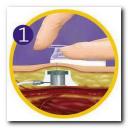I have been meaning to write a post about Nora’s port for a while since she seems to be the exception when it comes to having a port instead of a broviac for a child her age. We have had parents ask us about her port in the past when considering what is best for their child so I wanted the information and our experience with it to be available.
The port itself is implanted under the skin on Nora’s chest and is connected to a catheter which runs into her jugular vein. The port is accessed by a huber needle which goes through the skin into a silicone membrane material which is connected to the catheter leading into in the vein.
When the port is not accessed (no needle in) there is just a small bump on Nora’s chest (about the size of 3 stacked dimes) that requires no dressing. One of the benefits of a port is that when there is no needle in the patient can get completely wet and not have to worry about infection since the port is implanted completely under the skin.
On the other side, each access requires a needle stick. It sounds unpleasant but as long as we use numbing cream, Emla, Nora doesn’t feel a thing. We change the needle once a week. An IV port, Infusaport and a Port-a-cath are all different names for the same device, just different manufacturers and size but the general construction is the same. Nora has a Bard SlimPort. The picture below is very similar to Nora’s in size and shape.
On the outside of the skin, the huber needle is connected to IV tubing which is about 6 inches long. At the end of the line an end cap is attached, just like the end cap on a broviac line. There are butterfly wings on the top of the needle to brace it on the skin. We usually put a Bio-patch (the little circle pad) between the needle wings and skin to help prevent infection as long as Nora’s skin is not irritated.
Nora never had a broviac, she went straight from a PICC line to a port so we don’t have the personal experience to compare the two. I’ve heard other parents say that they prefer one and other parents prefer the other, so there is no best answer, each patient and family has to weigh the options and try to figure out what’s best for thier child. If Nora had a broviac when she decided to tear off her dressing and remove her line last month then she would have had to gone into surgery to get a new line put in. But with a port we just put a new needle back in. No surgery is obviously good but having a needle to possibly injure herself with, not so good. And of course there are plenty of stresses that come along with the weekly needle changes, even though usually it goes very smoothly, when it doesn’t it can be extremely stressful and a risk for Nora if it is not done properly.
The average number of sticks a port can take before it needs to be replaced is 1,000-2,000. So if you only have to change the needle once a week it will last a long time as long as the patient doesn’t outgrow it first. Dr. Crooms estimated that Nora will need to have her port replaced when she is around 2 years old, she has had it since she was 2 months old.
All of Nora’s doctors believe that the infection rate is lower with a port but then there are other doctors who feel that a broviac has a lower rate. From our personal experience, Nora has never had an infection with her port in the 16 months she has had it and hopefully she never will. I guess the last difference I can think to mention is that the patient will have a bigger scar from having a port implanted over a broviac. Nora has two very small scars that are barely noticable, one over the port and one on her neck. Overall we have been very pleased with Nora’s port. Unfortunatley there is no such a thing as a “stress free” CVL but some parents may find the pros and cons will outweigh in favor of one or the other according to the needs and temperment of their child. I am not pushing a port over a broviac, we do not have any personal experience with a broviac, but I hope some will find our insight helpful when weighing the options.



Hi my name is Aixa Gonzalez, Im a medical student in my last year of studies in Caracas, Venezuela. While looking for information about Port catheters (one of the pediatric patients I have assigned needs one for his quemotherapy) I fell into you blog and I just wanted to tell you how moved I felt by the whole story of Nora’s experience. She is just adorable, I am very happy to see how kids like her can live such a normal life despite her medical issues and I think its just amazing the way you have handle it. I wish Nora only the best for her life, and also I am very glad to see the good relationship your family has with her Doctor, I wish someday I could mean so much to a family as their children pediatrician.
PD: Excuse me if a have some mistake in my English writting, im still practicing!